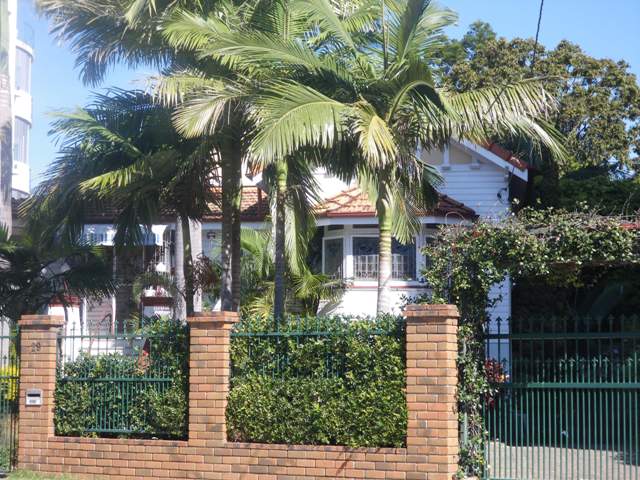Addresses
Type of place
House
Period
Interwar 1919-1939
Style
Bungalow
Addresses
Type of place
House
Period
Interwar 1919-1939
Style
Bungalow
This riverfront residence was built circa 1926 for Chinese herbalist William Chong and was designed by George Thornhill Campbell-Wilson, who is perhaps best known for his work on the Ambassador Hotel in Scarborough. Chong was one of very few Chinese residents living in Brisbane in the 1920s, due in large part to the strong anti-Chinese sentiment that lingered after the commencement of the Government’s White Australia Policy. However, Chong enjoyed a successful career in Brisbane and practised for many years in the area now known as Chinatown, in Fortitude Valley’s Wickham Street.
Lot plan
L16_RP8732
Key dates
Local Heritage Place Since —
Date of Information —
Construction
Roof: Terracotta tile;Walls: Timber
People/associations
George Thornhill Campbell-Wilson (Architect);Mun See Lee (practising as William Chong) (Occupant);
W. Thurlow (Builder)
Criterion for listing
(A) Historical; (E) Aesthetic; (H) Historical associationInteractive mapping
Lot plan
L16_RP8732
Key dates
Local Heritage Place Since —
Date of Information —
Construction
Roof: Terracotta tile;Walls: Timber
People/associations
George Thornhill Campbell-Wilson (Architect);Mun See Lee (practising as William Chong) (Occupant);
W. Thurlow (Builder)
Criterion for listing
(A) Historical; (E) Aesthetic; (H) Historical associationInteractive mapping
History
This imposing riverfront residence is built on two lots that were originally part of the 4 hectare Merthyr estate owned by Sir Samuel Walker Griffith, Premier of Queensland from 1901-1902. The Merthyr Estate was one of the last estates to be subdivided after Griffith’s death in 1920. Part of the estate was placed in the trusteeship of Mun See Lee, a Chinese merchant. Griffith Street was created as part of this subdivision and was named after him. The suburb of Merthyr is named after his birthplace in Wales.
The residence dates from c1926 when William Chong, applied to build a house on lots 16 and 17. Prior to the building of this house, he lived in Sydney Street, New Farm. William Chong was a prosperous Chinese Herbalist working in Wickham Street in Fortitude Valley. This business precinct would become known as “Chinatown”. Little else is known about Chong’s background. However, it is known that very few Chinese people lived in Brisbane in the 1920s – the greatest numbers living in north Queensland. In the 1933 census just 220 Chinese males lived in metropolitan Queensland, while nearly 1800 lived in rural areas. It is possible that this successful Chinese merchant wanted to build a large, federation style house on prestigious river frontage to symbolise his prosperity and success. It is remarkable that in a social climate in which racist attitudes prevailed and the Government’s White Australia Policy actively discouraged people of non-British backgrounds from settling in Australia, he was successful enough to build this prominent riverfront home. In 1938 Chong sold the property to George Herbert Bushell and appears to have finished practising as a traditional herbalist.
The residence was designed by George Thornhill Campbell-Wilson and built by W. Thurlow of Yeronga. G.T. Campbell-Wilson was a local architect, born and bred in Brisbane. This is the first house for which he called for tenders from builders as an architect. He built at least four houses in Brisbane with Thurlow in 1926. Campbell-Wilson is best known for his design of the Hotel Ambassador in Scarborough, also in 1926.
Description
This house was built in 1926 and it displays some characteristics of the inter-war Californian Bungalow style of that era, including porthole windows and imitation shingle cladding below bay windows. However, its form and materials are more characteristic of the earlier Federation/Queen Anne style.
The multi-gabled roof is clad in terra-cotta tiles with finials, projecting decorative ridge beams and simple masonry chimney. Window hoods are also terra-cotta tiled on timber filigree frames.
A projecting semi-octagonal corner turret and bay window are sheeted below sill level with decorative boards notched to imitate shingles. Windows to these elements are timber framed casements with leadlight glazing art-nouveau designs. Adjacent small ‘port hole’ windows are also leadlighted.
Wall sheeting is dressed chamferboards and the wide front stairs are built of masonry. A more recent extension to the rear, apparently post 1955, has glazed walls and a flat roof with terra-cotta tile fascias.
Statement of significance
Relevant assessment criteria
This is a place of local heritage significance and meets one or more of the local heritage criteria under the Heritage planning scheme policy of the Brisbane City Plan 2014. It is significant because:
References
-
The Architects and Builders Journal of Queensland, 10 May 1926
-
Brisbane City Council Register of New Buildings, July 1926 no. 8281
-
Brisbane City Council Water Supply and Sewerage Detail Plans
-
Department of Natural Resources, Queensland. Certificates of Title and other records
-
Government Statistician. Queensland Year Book 1946. Brisbane: Government Printer, 1946
-
Kennedy, Michael Owen. Domestic Architecture in Queensland Between the Wars. Unpub Thesis. Master of Built Environment. 1989
-
Musgrave, Elizabeth, Kaylee Wilson and Brisbane City Council Heritage Unit. New Farm and Teneriffe Hill: Heritage and Character Study. October 1995
-
Queensland Post Office Directories, 1925-1939
-
Schiavo, John, New Farm: A Study of Land Use and Settlement to 1999. (Brisbane: Schiavo, 1999)
-
Watson, Donald and Judith McKay. Queensland Architects of the 19th Century: A Biographical Dictionary. Brisbane: Queensland Museum, 1994
Citation prepared by — Brisbane City Council (page revised September 2020)

